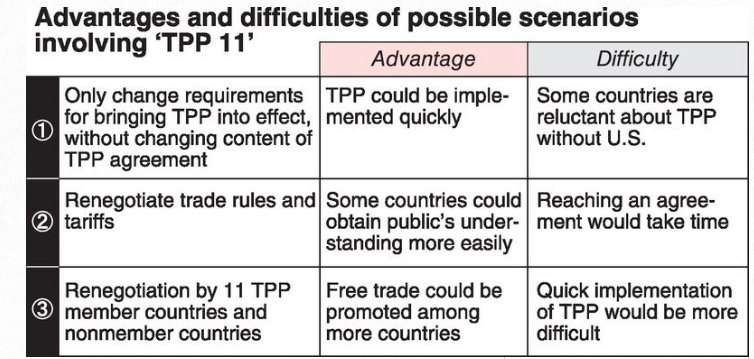Differing motives complicate ‘TPP 11’

Japan News | 2 May 2017
Differing motives complicate ‘TPP 11’
By Sachiko Aoki
Eleven countries participating in the Trans-Pacific Partnership free trade pact, including Japan and Australia, will hold a chief negotiators meeting in Toronto on Tuesday and Wednesday, to kick-start full-scale discussions toward implementation of the pact by the 11 countries, without the United States.
Japan, the largest economy among the 11, hopes to take the lead in the discussions. Each country has different motives regarding the framework of “TPP 11.”
The meeting in Toronto is positioned as a preparatory gathering for a TPP ministerial meeting to be held in Vietnam on May 20 and 21. The focal point is to what extent these countries will be able to indicate a direction for the TPP 11.
Ahead of the chief negotiators’ meeting, Nobuteru Ishihara, the minister in charge of TPP affairs, held separate talks by telephone and other means with New Zealand Trade Minister Todd McClay and Canadian International Trade Minister Francois-Philippe Champagne, confirming that they would closely cooperate with each other.
Ishihara said at a press conference after a Cabinet meeting Friday, “The Canadian government asked Japan to play a central role,” suggesting that Japan would take the lead in the discussions going forward.
At a ministerial meeting held in Chile in March, the 11 countries issued a joint statement outlining the participating countries’ confirmation of the strategic and economic significance of the TPP. There is no major difference of opinion among the countries in terms of the importance of high-quality trade and the investment rules agreed upon in the TPP.
However, the countries compromised in many areas, based on the participation of the United States with its large-scale economy.
“There is no big difference in that all countries hope to take advantage of the fruits of the TPP, but opinions vary on how to do it,” said a source close to the TPP negotiations, explaining the current situation.
3 scenarios
There are three main possible scenarios from here on.
First, the participating countries could modify just the requirements to bring the TPP into effect, without changing the content of the agreement. As things stand, the TPP pact comes into force after six countries that account for 85 percent or more of the signatories’ combined gross domestic product complete their domestic procedures.
Since the United States alone represents more than 60 percent of the GDP, it is impossible to bring the TPP into effect at present.
The first scenario would change the requirements in order to implement the TPP by the 11 countries at an early date.
Japan, Australia and New Zealand are positive about the plan. They also intend to put a brake on the United States, which favors bilateral trade negotiations, by indicating their intention not to compromise any further with the United States than they did over the TPP agreement, according to a Japanese source close to the TPP negotiations.
The second scenario would be to hold fresh negotiations on issues including the content of the TPP agreement, such as trade and investment rules, with the aim to implement the TPP afresh.
Vietnam and Malaysia agreed to relax domestic regulations and open their markets in return for access to the huge U.S. market, so these countries are negative about participating in the TPP 11 without the United States. However, if the participating countries go into the details of the agreement, the negotiations will be unavoidably prolonged.
The third scenario would establish a new free trade zone by adding countries other than the 11 TPP member countries, based on the content of the TPP agreement. The South American countries of Chile and Peru are interested in the plan, eyeing the participation of China and other countries. However, this scenario would require negotiations to start from scratch. There is also strong caution about China’s participation.

Influence of RCEP
While the TPP is adrift, China and the Association of Southeast Asian Nations countries have indicated a willingness to conclude the Regional Comprehensive Economic Partnership with the participation of 16 countries, including Japan, China and South Korea, by the end of this year.
While Japan fundamentally supports free trade, it hopes to avoid a scenario in which the RCEP, which allows for lesser degrees of market opening than the TPP, comes into effect ahead of the TPP and takes root as trade and investment rules for Asia.





